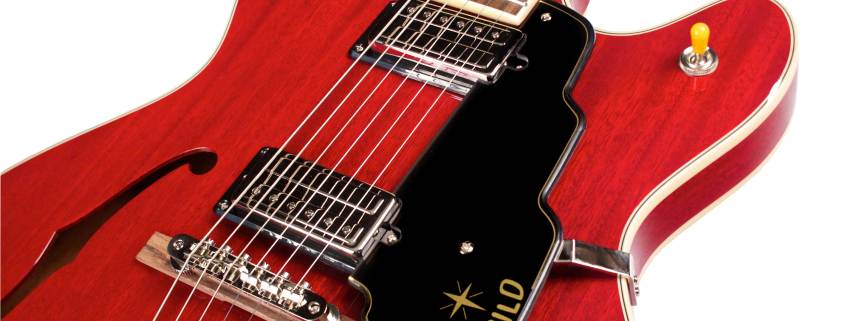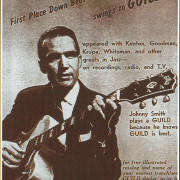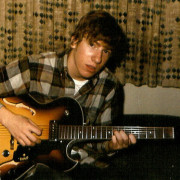A Deeper Look at the Starfire Pickup
When developing the Newark St. Series Starfire guitars, we wanted to recreate the magic that was found in a handful of original pickups we came across. A large number of guitars were meticulously tested and compared in order to find the most awe-inspiring pickups with that magical sound. Sure, we tested numbers and metrics along the way, but our primary driver in selecting the pickups to recreate was our ears. In the end, we chose the best sounding pickups that we could find and replicated them with the utmost care and detail.
The Starfire’s LB-1 Little Bucker pickup sits somewhere between a mini-bucker and a full size humbucker. Tonally, it’s got a little more jangle and a little more air then a traditional humbucker. The resistance and inductance of these pickups sit comfortably between a typical single coil and a typical PAF style humbucker – contributing to the airy nature of the pickup without compromising its warmth and hum-free output.
Recently, we’ve been asked why our Starfire pickups have a lower resistance measurement in the bridge pickup than measures in the neck pickup. While we understand why this question is asked (because many people use the resistance to measure pickup output), measuring output with resistance alone fails to account for a multitude of impacting factors.
Guitar pickups can be measured a few different ways: resistance (ohms K), inductance (Henries) and output in millivolts are all typical measurements. While any of these measurements can give you a ball park estimate of your pickup output (when compared to another identical pickup), they don’t tell the whole story. For that, you’d need to compare all three different measurements as well as components used and overall pickup efficiency. For example, the Starfire bridge pickup does have a lower resistance than the neck; however, it is wound with 41g wire. The neck pickup is wound with 42g wire. This difference in component alone will impact the resistance of the pickup. 41g is a thicker wire and as you increase your wire thickness, you decrease the amount of resistance.
It’s easy to fall into the trap of specs and speculations but in the end, you should always count on your ear because after all, it’s our ears which we are trying to please!










This is interesting, but doesn’t explain the drop of volume that has been the subject of discussion at the Let’s Talk Guild forum. The reason people measured the DC resistance of these pickups was because a number of us have noticed a significant pickup balance problem that guitars with this pickup set seem to experience. I have a GSR T-400 with the same pickup set and the volume drop on the bridge pickup alone is significant in spite of the bridge pickup being as close to the strings as possible without interference.
Did you remove the covers from any of the pickups you tested? The reason I’m asking is that I removed the covers from a 1960s Starfire II I owned which had identical looking pickups, only to discover a single large coil wrapped around a single bar magnet. Unless the pickups on my guitar had a second coil under the magnet that I completely missed before I replaced the covers, no way were they humbuckers!
I bought a Starfire V on august of 2014. For some reason my pickups are distorting too much when I push my Amp volume.
I have a Special Edition Blues Junior III and also an American Standard Stratocaster and a Standard Epiphone with Gibson Classic 70 Hum-buckers on it. Nono of this have any issues pushing my amp volume (master volume not the Gain) up, but as soon as I pass 4 or 5 and have full volume on my Guild master and pickus my sound is too distorted.
Any one have this issue?
I have a 1964 SF 4 am wanting ti buy a new set of these to try in my guitar .Anyone selling just the pickups ?Thanks .D
I have a 2014 Guild Starfire IV and I have to roll back the tone to 2 or 3 because I find these pickups are too hot – played through a Mesa Boogie Express 25. Any ideas on this or should I switch out my pickups to something else? Looking for that classic blues sound. Played through my Fender Blues DeVille with the same results.
Pickups may be set too high. For humbuckers (bridge and neck), try setting the distance from the bottom edge of the low E string to the pole piece below it, 3/16 to 7/32 of an inch (varies with output). Then set the other height-adjustment screw(s) so that the pickup body is even (parallel) with the pickup ring on all 4 sides. Additional fine-tuning might be made with the individual pickup screws under each string. Finally, work with your amp controls (not the guitar’s), and any effects, to get your final sound.
It was very common in the sixties for guitar makers to fake a humbucker look by putting height adjusting screws in one side of the housing so that they looked the same as a PAF from the outside, but were single coils inside. Eastwood replicates these old-timey pickups on their recreations of Airlines and others–and they tell you up front that they are single coils. Personally, I like the sound of the fake humbuckers. They’re ballsier than a strat pickup without the deadly dullness of a P-90. Some of the “gold foil” reproductions out there are done this way, and for the most part, I like them.
By the way, the present day Guild LB-1s are real humbuckers just like they say
For those of you have owned/player a 335…how does the neck compare to the Starfire?
Thanx,
How can you tell the age of your Guild, I have been playing it since 1963 and would like to know the age?
If you’d like to learn the truth, I’ve done a lot of experimenting with vintage AntiHum and modern LB1 pickups. You can read about them here:
Guide to AntiHum and LB1 Pickups: http://www.gad.net/Blog/2018/03/09/guild-anti-hum-lb1-mini-humbucker-pickups/
Vintage AntiHum teardown: http://www.gad.net/Blog/2018/03/13/guild-antihum-mini-humbucker-pickup-teardown/
I have high hopes for Guild under the new ownership and think that they should take responsibility for this, correct the design in the bridge pickups and carry on. It would send a message that the new owners of Guild guitars have integrity and really want to do things right. It will be a positive contrast to the news about a certain other guitar company that was brought down by bad management.
The truth about these pickups: http://www.gad.net/Blog/2018/03/09/guild-anti-hum-lb1-mini-humbucker-pickups/